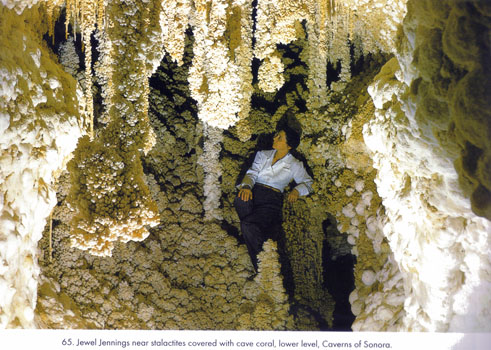 |
 |

As cameras improved and personal photography became more accessible to tourists, this dichotomy between tourist-photographer and traveler-photographer became even clearer as many tourists strove toward 'artsy shots' themselves, which only the professional photographers had been producing before. In fact, both trends present issues for cave owners. Developer Jack Burch reasoned that Sonora Cave needed to be commercialized to protect its delicate splendor from its visitors. He said, "Photographers were the worst. They wanted people in the picture, so that meant that someone had to climb on a fragile formation to pose. Cavers were not following in the footsteps of others. Everyone wanted to start their own, new trail" (Pittman 1999).
In the golden age of caving in America, as the public was first becoming aware of the splendor of the undergrond world, and were awestruck by the vastness of such caves as Carlsbad, much of the public was interested in seeing pictures which gave some indication of the size of the formations relative to the average person, as seen in just the few early pictures depicted along this tour. Furthermore, having an individual in the picture helps to validate the photo's truth claim. Even today, this validation phenomenon remains true. It is not uncommon in fact, for couples to request a marriage in a cave setting, which almost always requires a wedding shot on or near a particular formation. The caverns of Sonora identify certain locations specifically for such ceremonies and their attendant photography, in part to minimize damage. But this desire to capture the cave in a personal artistic rendering is not limited to the performance of ceremonies or the professional photographer. It evidences itself amongst the general tourist population as well, and all of these subjects make the cave owners' job of protecting the invaluable formations difficult.
A clipping from a 1937 editorial piece regarding tourist photographers stressed the contentious duality cave owners and operators must navigate:
"Candid Cameras:Second only to house trailers, I believe that candid cameras are developing into somewhat of a nuisance in this national park. The amateur photographers are of course encouraged to take all of the pictures they want to on the surface but it is certainly annoying when one is conducting several hundred tourists through the cavern to have someone pull a collapsible tripod out of their pocket and set it up in the middle of the trail and delay hundreds of people while the photographer makes a picture which probably could be purchased for five cents. Some visitors insist on putting their children on top of formations for a photograph, and openly resent our request that they remain on the trails, which after all is the safest place in the cavern. They seem of the opinion that we are depriving the Carlsbad Cavern of some favorable publicity, but at the same time I believe that protection of our formations against defacement, and safe conduct of our visitors over the underground trails, is of much more importance to the future of the Carlsbad Cavern than the possible publicity which might be obtained from an amateur who, nine times out of ten, knows little if anything about operating the Kodak."
Carlsbad Caverns CAVE History Update: A Newsletter from CAVE Cultural Resources in the Resource Stewardship and Science Division CHU #10, August 31, 2004 (August 1937, Superintendent's Monthly Report)
It became apparent that certain tourists while trying to capture that perfect image, whether of the landscape, or of themselves in the landscape, were not adhering to the regulations enacted by Park Rangers and cave owners, and represented a danger to the preservationist policies of the caves. In a move to accommodate these photographers and artists (especially those of Crang's traveler persuasion) while still enacting appropriate conservation measures, many caves are now offering special "photography tours." These tours allow a visitor to bring a tripod and be assisted in setting up to capture the perfect image. Smaller group sizes allow more time to be spent at any particular formation without the danger of other tour groups damaging the photographer's gear as they pass by. Some off-trail movements may be allowed under the guidance of the accompanying Ranger/guide in order for the photographer to get the best angles and lighting. In addition to helping to authenticate the tourist's experience, the pictures that are taken on these types of tours often re-enter the visual economy--whether as art or other objects--and thereby help to extend the discursive formations enacted by the site. In this manner, these types of tours can prove doubly profitable to the cave owners/operators as a means of marketing as well.
Cave photography works to join a particular community of artists together too, as can be seen in published anthologies and in peer groups of speleologists and avid cavers. In fact, the National Speleology Society has established the NSS Salons to provide a forum for "Promoting caves and caving by conducting juried salons, and by exhibiting items of speleological interest." While the salons are heavily invested in cave photagraphy and other forms of representational art, they even have offerings for poets, songwriters, and mapmakers. Click here to view or hear selections from the online NSS Salon. The salon provides an ideal method to promote the discursive of the artist, engender corporate preservationism, and provides incentive for individuals to paricipate in the expansion of these discoures for monetary or reputational gain. Most of the particpating formats however, require the artist to find a way to negotiate a less regulated interaction with the cave landscape than traditional show tours offer in order to create their salon submission.
[ Back ] | [ Continue Tour ] |